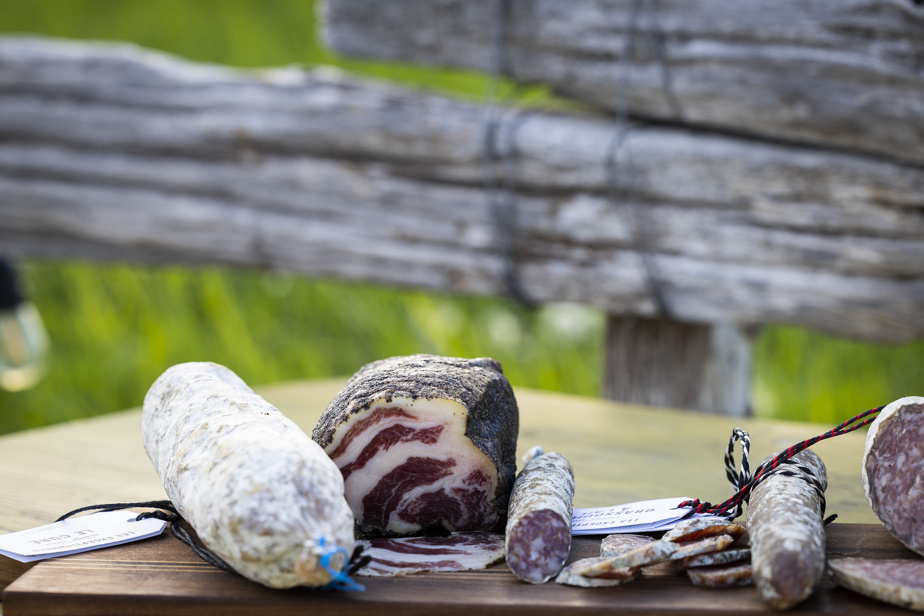(Sainte-Anne-de-la-Pocatière) Nathalie Joannette produced her first sausages almost 20 years ago. You had to see her prepare for the photo shoot in the flats of the St. Lawrence River to see how much her passion is still alive.
“I was hooked, I fell into something, I would never have thought in my life to have a kick like that on a profession that I was discovering, which fascinated me,” recalls the owner of Fou du porc, recalling remembering the beginnings of his adventure, the spark of which ignited during a drunken evening in the company of Belgian friends.
“My father is French, then Samuel, my ex, with whom I started the business, his mother is Swiss; we therefore found ourselves with a nice Quebec-Europe mix around the table,” continues the woman who worked at the time as a psychosociologist.
At one point, we said to ourselves that there were no good sausages in Quebec!
Nathalie Joannette, co-founder, Fou du porc
Elevated to the rank of a culinary art in its own right in France and elsewhere in Europe, charcuterie did not resonate in the same way on this side of the Atlantic. “In France, I’m seen as a doctor, it’s serious there, they’re crazy and stiff, they roll out the red carpet for me,” says the craftswoman who was made a knight of the order of French charcutiers in 2018. Here, it’s not in our DNA, everything that is lactofermented in meats, we don’t know that, we didn’t see our grandfather make it. We don’t have family stories like in Europe, there is no one here who walks around with an Opinel in their pocket, ready to cut their sausage at any moment. »
It was in 2003 that Nathalie Joannette ordered two French reference works, after which she began to carry out experiments trying to cultivate the bacterial flora specific to Kamouraska. It all started with his friend Charles Marois, who then owned a butcher’s shop adjacent to his farm. “We opened the windows of our little butcher shop, then everything dried in the air like that,” remembers the woman who settled in Bas-du-Fleuve almost 25 years ago. We rubbed the sausages on the walls and on the maple wood, because it is porous and the good bacteria, yeasts and fungi settle in the pores of the wood, it is really an excellent support for this microflora . »
Secret recipes

PHOTO PATRICK SANFAÇON, THE PRESS
Fou du porc offers a variety of entirely organic and natural sausages and cured meats.
Fou du porc has opted for all-natural products, and to this day it is still the only one in Canada to proceed in this way, by allowing the only bacterial ecosystem present in Kamouraska to act in the drying process of its sausages. But the secret also lies in the recipes developed by Nathalie Joannette.
One of the first products we made was the bell of the batures, it was the one that won the gold medal in France. Here we took Scottish lovage which grows in the brackish marshes on the banks of the river. We make a pesto out of it and then mix it with our meat.
Nathalie Joannette, co-founder, Fou du porc
Elsewhere, we took inspiration from classic recipes, such as for the filbert stick, nuts reminiscent of the hazelnut present in many European sausages. But Nathalie Joannette above all wants to use local ingredients: “We embrace our Nordicness, we want it to be present in the signature of our products, we want it to be obvious that we are not in South America! “, she says, laughing.
Rigorous processes

PHOTO PATRICK SANFAÇON, THE PRESS
The different types of sausages will take more or less time to mature in the dry cell. The largest ones, like Le Curé, will remain suspended for almost three months, losing a significant part of their volume in the process.
If the quality of Fou du porc sausages depends on its ingredients, it is also dependent on extremely rigorous processes. Nathalie Joannette may have imagined her business during a party, but her approach could not be more scientific.
In the Sainte-Anne-de-la-Pocatière factory located in the Quebec Biofood Development Center, nothing is left to chance. “You don’t want the meat to heat up because you want it to dry,” she begins by illustrating. Often, you will see in people who are starting out in charcuterie that there are holes inside their sausages; This is because the fat has separated from the flesh. This is why we measure the temperature of the meat before grinding as well as when it exits the casing so that there is no difference anywhere. »
Finally, we must ensure that the sausages are sufficiently dry before being placed on the shelves, which is why we will first provide a steaming period at a temperature of 24 degrees before finalizing in a dry cell between 12 and 14 degrees for days or weeks, depending on the size of the cold cuts. “Ultimately, we will also measure the water activity in the sausages, that is to say what water remains in the product,” explains the artisan. The more water, the more bad bacteria can occur. »
In short, we are a long way from the days when we mixed saltpeter with sausages to ensure that they dried adequately!
Visit the Fou du porc website
